![]()
![]()
![]()
Use LEFT and RIGHT arrow keys to navigate between flashcards;
Use UP and DOWN arrow keys to flip the card;
H to show hint;
A reads text to speech;
32 Cards in this Set
- Front
- Back
|
What are the 3 components of the cell cycle?
|
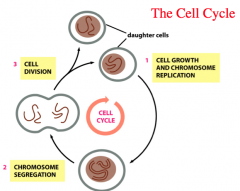
|
|
|
G1 Phase
|
Action: RNA and protein synthesis
duration: 6-12 hours |
|
|
Restriction point/G1 check point (START in yeast)
|
Action: Cell is committed to S phase if it passes this checkpoint
Assesses if the environment is favorable. Major checkpoint in eukaryotes |
|
|
S Phase
|
Action: DNA Synthesis; RNA and protein synthesis
Duration: 6-8 hours S phase takes a long time because DNA replication needs to be accurate. |
|
|
G2 Phase
|
Action: RNA and protein synthesis
Duration: 3-4 hours |
|
|
G2/M checkpoint
|
Action: checkpoint to enter mitosis
Is all the DNA replicated? Is the environment favorable? |
|
|
M Phase
|
Action: Mitosis, Cytokinesis
Duration: 1 hour |
|
|
Metaphase-to-Anaphase transition checkpoint
|
Action: Checkpoint to trigger anaphase and proceed to cytokinesis
Are all chromosomes attached to the spindle? |
|
|
G0 phase
|
Action: brain cells, neurons, and spinal cord don't divide and enter G0 phase after terminally differentiating
|
|
|
Which phases are part of interphase?
|
G1, S, and G2
|
|
|
Checkpoints operate through ______ control.
|
negative
|
|
|
Two ways to study cells in the cell cycle
|
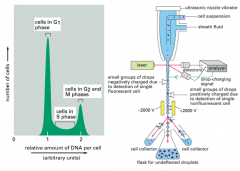
1. Segregating cells based on the amount of DNA using a flow cytometer lets you isolate cells as either from G1 or G2
-G1 cells have one unit of DNA because they have an unreplicated complement of DNA -G2 cells have two units of DNA because they have a fully replicated complement of DNA 2. Birthdating Cells -pulse a cell with specific radio labeled DNA nucleotide during certain periods of development. You can then confirm that any cells that took up that specific DNA label were born during the same pulse period. |
|
|
Cell-Cycle Control System Models
|
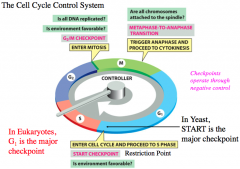
In the dominos model, the next phase cannot happen unless the previous phase has been completed-- like dominos.
In the washing machine model, a central regulator works as a recipient of information to govern movement. The washing machine model is the correct model* |
|
|
Cell-Cycle Control System
|
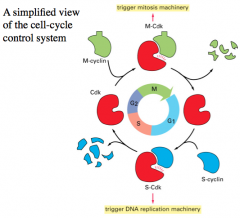
The cell cycle is controlled by a protein kinase-based machine.
Cyclins regulate the activity of Cyclin-dependent protein kinases (Cdk) which are serine/threonine protein kinases. 1. An inactive G1-Cdk becomes active when an S-cyclin phosphorylates it to pass the G1 checkpoint 2. The S-cyclin degrades 3. The Cdk then recruits an M cyclin which triggers mitosis 4. Degradation of the M-cyclin |
|
|
Classes of cyclins: G1/S-cyclin
|
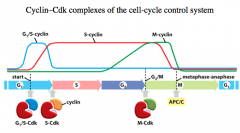
Mechanism: Help trigger progression through Start. Commitment to cell-cycle entry
Expressed: Activate Cdks in late G1 Degraded: S phase |
|
|
Classes of cyclins: S-cyclin
|

Mechanism: help stimulate chromosome duplication and contribute to the control of some early mitotic events
Expressed: Bind Cdks soon after progression through Start Degraded: Mitosis |
|
|
Classes of cyclins: M-cyclin
|

Mechanism: stimulate entry into mitosis
Expressed: activate Cdks at the G2/M checkpoint Degraded: Mid-mitosis |
|
|
Classes of cyclins: G1-cyclin
|
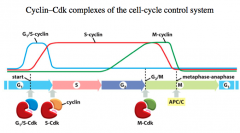
(only some cells have this- its rare)
Mechanism: help govern activities of the G1/S cyclins, which control progression through Start Expressed: Late G1 |
|
|
The Structural Basis of Cdk Activation
|
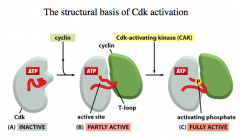
Cyclin isn't the only thing thats needed to activate a Cdk.
Cyclin binding will make a conformational change so that the T loop becomes available for phosphorylation. A Cdk-activating kinase (CAK) then phosphorylated the Cdk to fully activate it. CAK & cyclins both activate Cdk's |
|
|
Cell Division Mutants
|
1. cdc (cell division cycle) mutants
-deficiency in a gene product required to get past a checkpoint leads to being ARRESTED at a specific point in the cell cycle 2. Wee mutants -deficiency in a gene that INHIBITS passage through a checkpoint leads to UNREGULATED DIVISIONS and smaller cell sizes. "wee"= "small" |
|
|
Regulation of Cdk activity
|
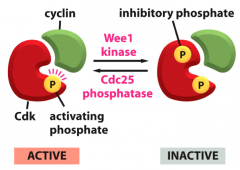
Wee1 kinase puts an inhibitory phosphorylation on the Cdk, while Cdc25 phosphatase removes the inhibitory phosphorylation to activate the Cdk.
CAK adds the activating phosphatase. |
|
|
Cyclical Proteolysis
|
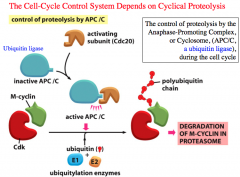
For every ON mechanism, there is an OFF mechanism. Regulated cyclical proteolysis of cyclin is necessary in controlling the cell-cycle.
Anaphase-Promoting Complex Cyclosome (APC/C), a ubiquitin ligase, controls proteolysis during mitosis. Inactive APC/C becomes activated when it binds Cdc20 (not Cdc25 from earlier), and along with ubiquination enzymes E1 and E2, marks M-cyclin for degradation. APC/C also degrades Securin, which activates a protease that separates sister chromatids, initiating anaphase. |
|
|
Securin
|
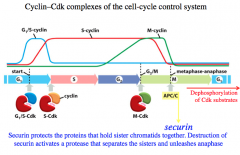
Securin protects the proteins that hold sister chromatids together. Destruction of securing activates a protease that separates the sisters and unleashes anaphase.
|
|
|
Regulation of Replication
|
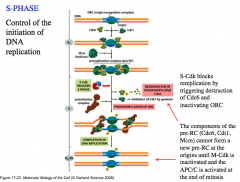
Many different Cdks sample the extracellular environment to regulate the cell cycle. But how can you make sure replication happens only once when many components exist throughout the cell cycle?
A pre-replicative complex (pre-RC) at the replication origin that is present throughout the cell cycle only becomes active with S-Cdk. In order to control the initiation of DNA replication, the ORC origin replication complex recruits proteins like Cdc6, Ctd1, and Mcm (helicase) to allow the formation of an inactive pre-RC that forms when Cdk activity is decreased and when APC/C activity is increased. Then the S-Cdk triggers the S phase and activates the pre-RC. The S-Cdk recruits the pre initiation complex, degrades phosphorylated Cdc5, inhibits Cdt1 via geminin, and phosphorylates the ORC to block re-replication. The pre-RC cannot form a new pre-RC until M-Cdk is inactivated and the APC/C is activated at the end of mitosis. In this way, the pre-RC and S-Cdk make sure replication happens only once. |
|
|
The activation of M-Cdk
|
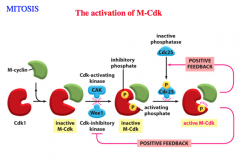
1. M-cyclin attaches to the Cdk1 and makes the Y-loop accessible (but the M-Cdk is still inactive.)
2. CAK and Cdk-inhibitory kinase Wee1 both phosphorylate the M-Cdk. Although the phosphate from CAK is activating, the M-Cdk is still inactive because the phosphate from Wee1 is messing everything up. 3. Cdc25 phosphatase becomes activated via phosphorylation to remove the Wee1's inhibitory phosphatase and now you have an M-Cdk! Active M-Cdk exerts positive feedback by (1) phosphorylating Cdc25 and (2) inhibiting Cdk-inhibitory kinase Wee1. M-Cdk also activates DBRP Destruction Box Recognizing Protein that triggers ubiquitination for degradation by a proteasome leaving the Cdk inactive. |
|
|
Proliferation genes
|
promote cell growth and assembly of cell cycle control system, and drive the cell past the G1 checkpoint
|
|
|
oncogene
|
if a proliferating gene has an activating mutation that leads to aberrant growth
|
|
|
Antiproliferation genes/Tumor Suppressor Genes
|
halt the cell control system
|
|
|
Retinoblastoma (Rb) gene as a regulatory protein
|
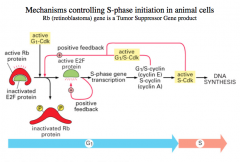
The retinoblastoma (Rb) gene is a regulatory protein that suppresses activity of elongation factors.
Phosphorylation by G1-Cdk --> inactivates the Rb protein --> release of the elongation factor --> S phase G1/S-Cdk complex can positively feedback and activate the E2F elongation factor. Therefore, mutation in Rb inhibits the inhibition of E2F and leads to inappropriate cell division. *mutation in Rb = mutation in tumor suppressor gene = uncontrolled growth* |
|
|
Mitogens
|
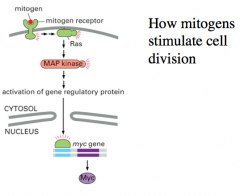
Mitogens stimulate cell division by binding to growth factors which are coupled to Ras which activate MAP kinase, which leads to transcription of primary response genes like myc gene. Myc can bind to a family of genes that increase expression of cyclins, Cdks, or proteins for cell division.
|
|
|
How do growth factors promote cell growth?
|

Cells sample the environment via growth factors and cytokines.
Growth factors promote cell growth by activating growth factor receptors which activate PI 3-kinase downstream. |
|
|
Nutritional Cell-Cycle Control
|
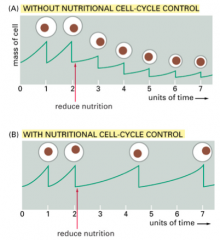
A network of sensors analyzes the environment before cell division, and these sensors govern the rate of the cell division cycle.
Without nutritional cell-cycle control, the cell keeps on dividing even though there aren't enough nutrients, which leads to a decrease in cell size. WITH nutritional cell-cycle control, cells don't divide until theres enough nutrition to do so. Therefore the G phase is longer, but the cells are a proper size. The really interesting thing about this, is that cancer patients respond better to chemotherapy when they fast before treatment. -no nutrition slows the growth of your healthy cells, but not the psychotic cancer cells, and now you can target treatment to only cancer cells. |

